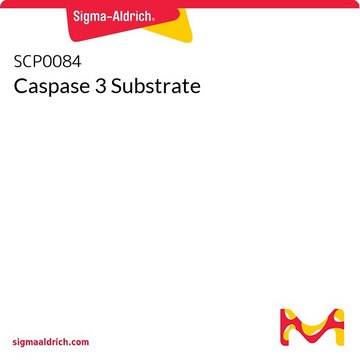Wszystkie zdjęcia(1)
Key Documents
C6607
Caspase 10 human
>90% (SDS-PAGE), recombinant, expressed in E. coli, lyophilized powder, 8,000 units/mg protein (Bradford)
Synonim(y):
Flice2, Mch4
Zaloguj sięWyświetlanie cen organizacyjnych i kontraktowych
About This Item
Polecane produkty
rekombinowane
expressed in E. coli
Poziom jakości
Próba
>90% (SDS-PAGE)
Postać
lyophilized powder
aktywność właściwa
8,000 units/mg protein (Bradford)
masa cząsteczkowa
~30 kDa
rozpuszczalność
PBS: soluble
numer dostępu UniProt
Warunki transportu
dry ice
temp. przechowywania
−70°C
informacje o genach
human ... CASP10(843)
Działania biochem./fizjol.
Caspase 10 has two death effector domains (DEDs) that bind to the DED in the adapter molecule FADD and recruits both TNFR1 and CD95 to form complexes with these receptors. Caspase 10 cleaves and activates caspases 3, 4, 6, 7, 8 and 9 which causes the proteolytic cleavage of many key proteins such as PARP. Based on gene expression studies, caspase 10 may be crucial in embryonic development. In view of its structural homology to caspase 8, the initiator caspase in death receptor-mediated apoptosis, caspase 10 may function in a similar and redundant manner.
Definicja jednostki
One unit will hydrolyze 1 nmol of the caspase substrate IETD-pNA to IETD and p-nitroaniline per hour at pH 7.2 at 37 °C.
Postać fizyczna
Lyophilized powder containing 0.052% ammonium sulfate, 0.158% Tris−HCl, and 0.76% sodium chloride.
This page may contain text that has been machine translated.
Kod klasy składowania
10 - Combustible liquids
Klasa zagrożenia wodnego (WGK)
nwg
Temperatura zapłonu (°F)
Not applicable
Temperatura zapłonu (°C)
Not applicable
Certyfikaty analizy (CoA)
Poszukaj Certyfikaty analizy (CoA), wpisując numer partii/serii produktów. Numery serii i partii można znaleźć na etykiecie produktu po słowach „seria” lub „partia”.
Masz już ten produkt?
Dokumenty związane z niedawno zakupionymi produktami zostały zamieszczone w Bibliotece dokumentów.
Caspases: the executioners of apoptosis.
Cohen, G.M.
Biochemistry, 326 (part 1), 1-1 (1997)
Marcin Poreba et al.
Nature protocols, 12(10), 2189-2214 (2017-09-22)
Many biologically and chemically based approaches have been developed to design highly active and selective protease substrates and probes. It is, however, difficult to find substrate sequences that are truly selective for any given protease, as different proteases can demonstrate
Nasz zespół naukowców ma doświadczenie we wszystkich obszarach badań, w tym w naukach przyrodniczych, materiałoznawstwie, syntezie chemicznej, chromatografii, analityce i wielu innych dziedzinach.
Skontaktuj się z zespołem ds. pomocy technicznej







